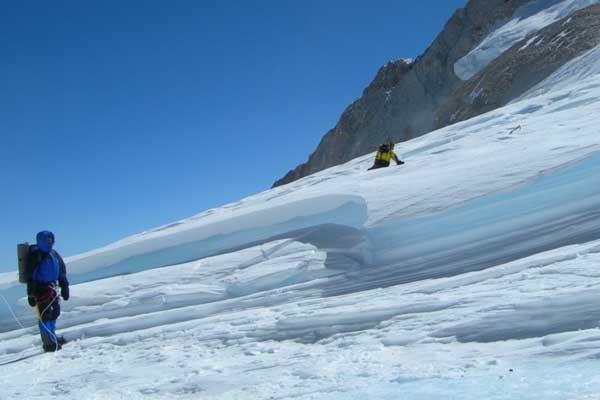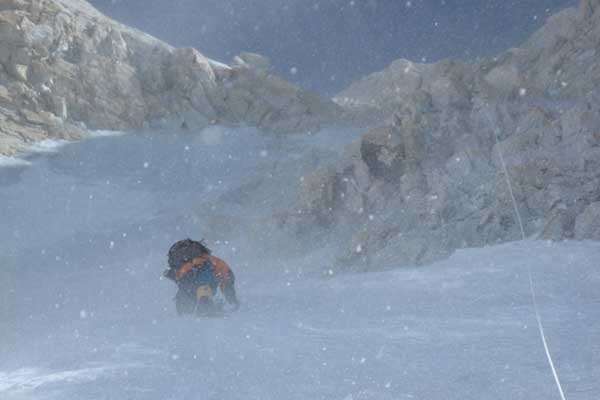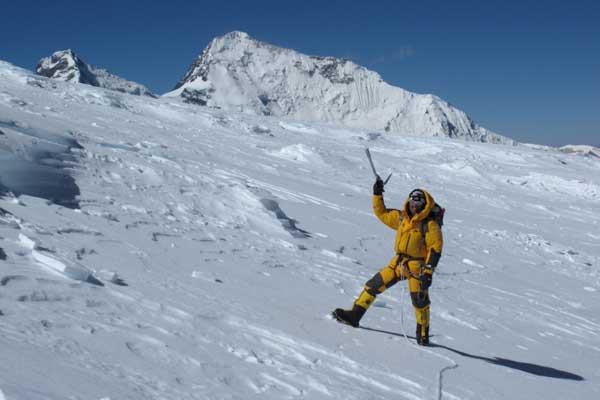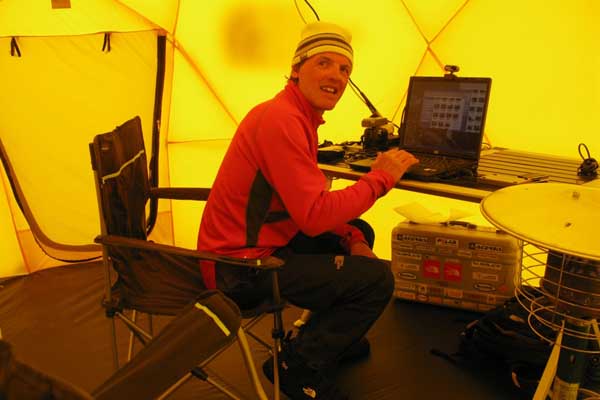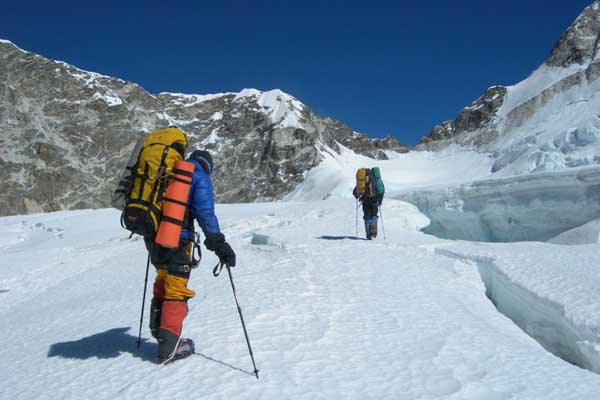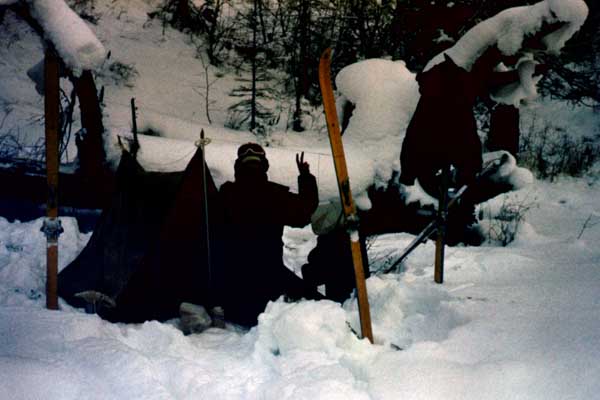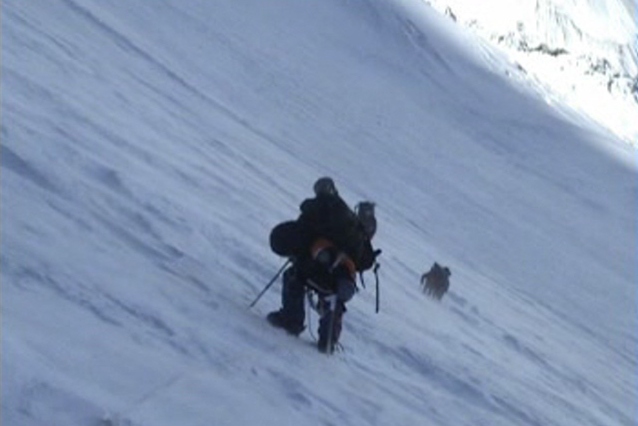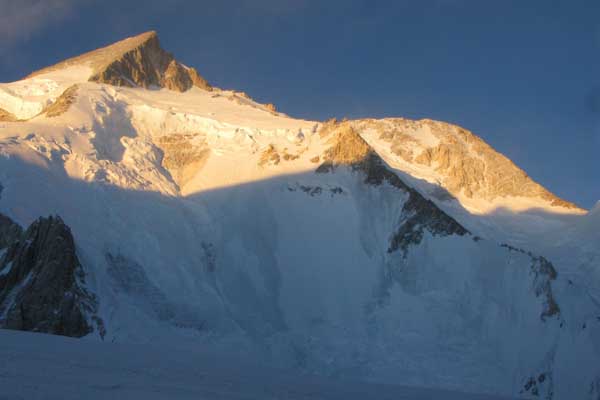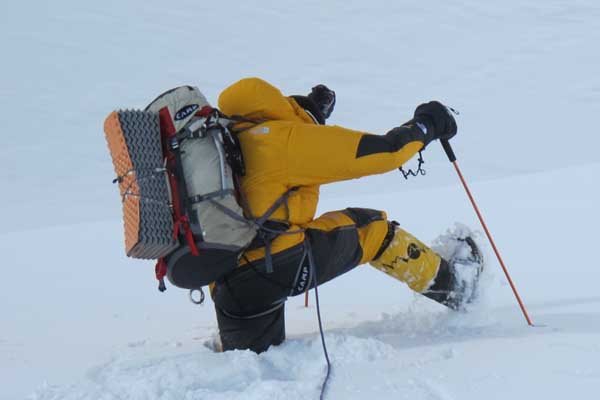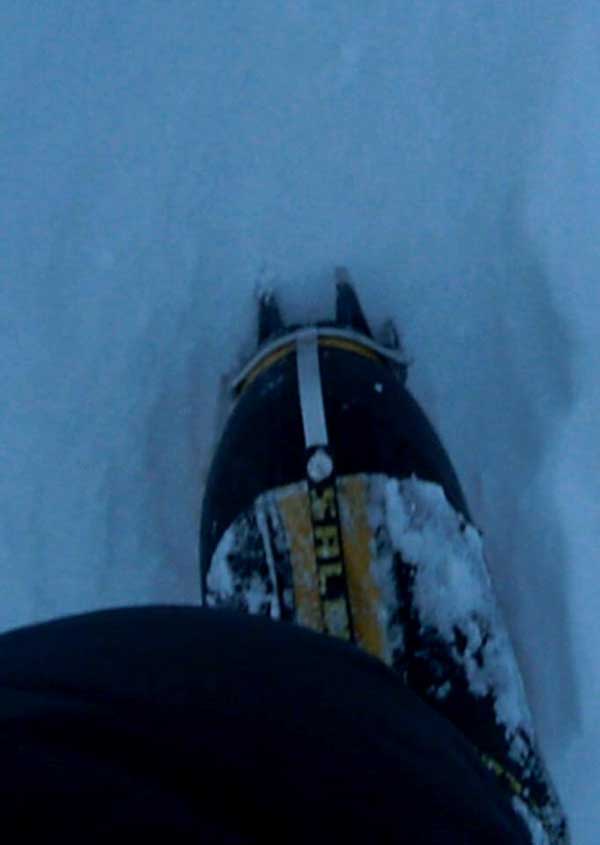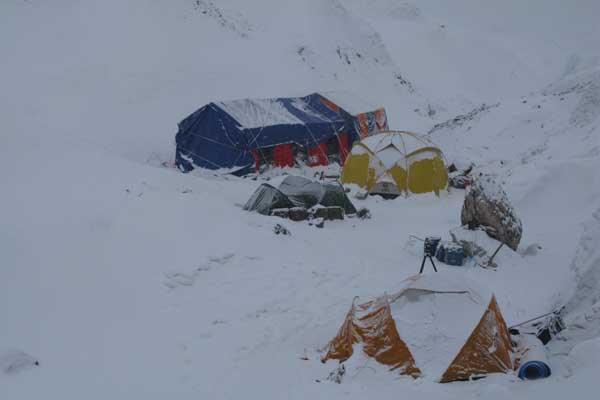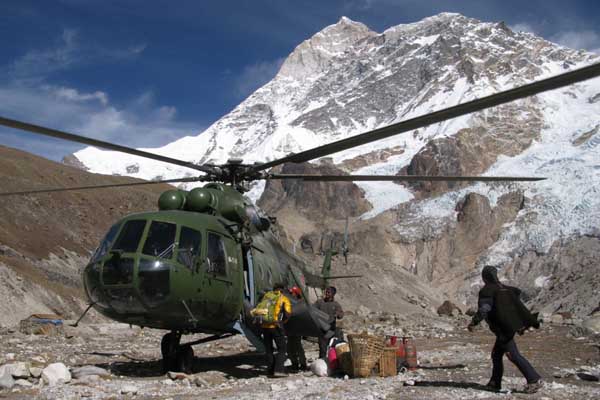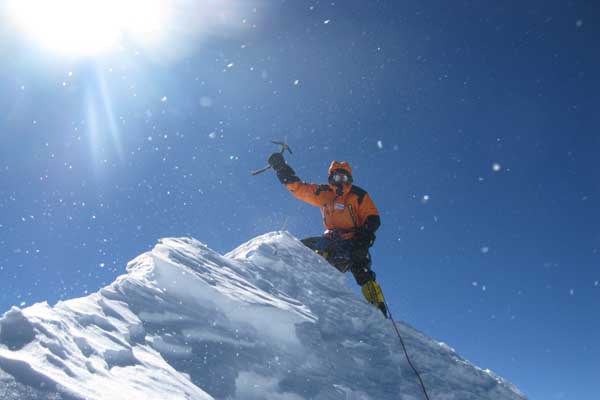

|
Denis Urubko: The real winter in Himalaya and Karakorum - what and why I consider as a winter ascent to summits over 8000 meters.
Ed. note: in 2004 French climber Jean-Christophe Lafaille made a solo ascent of Shisha Pangma. It was intended to be the first winter ascent of the mountain, he reached the summit on Dec, 11 Interesting, that some days before it the article about winter climbs in Himalaya was published on ExWeb part 1 and part 2. About "winter borders" between Dec, 22 and March, 21. So, Lafaille's success fell out of winter calendar... But not everybody support such winter borders. Denis Urubko wrote this article. We suggest to discuss...
The difficulties concerning to the definition of Himalaya and Karakorum winter season occupy our attention during many years The statement “what’s true winter”, in many respects, as well as the answer, depend on personal criteria and inquiries. The truth, as they say, disappears in the trifles. This question and the answer are interest for me too, I reflected on this subject within twenty years. And if I had been asked and involved in the discussion, I think it’s correct to designate my opinion. Remember, please, that people have the right for the various opinions which are often generated by bias. Therefore, I don't consider myself as the ultimate truth. However, I ask to keep in mind my notes made by the person, who’s "in the subject" Then, we’ll designate the axioms: 2. About the "heights and areas" I will consider the climbs on peaks higher than 8000 meters. They are in Central Asia in Himalayas and Karakorum regions. We’ll estimate the approximate altitude of the Base Camp as 5000 meters. All, which is below, are the approaches, it’s the mountaineering only theoretically (but there are the exceptions, for example, Nanga Parbat, so it is considered as one of the most difficult. But the accomodation in BC is much better. The mountaineering routes there start from 4300 m, above the Base Camp, and conditions there are very similar with other mountains). 3. Note, that the winter isn't identical in the different mountain regions and at the different heights. Besides, I’ll try to represent the "astronomical", "calendar" and "climatic" winter concepts, which are defined by the experts in the different periods. Let's go! First, I’ve to define the terms of “winter”. I am not a meteorologist and not the astronomer, my knowledge are limited by the personal experience and the weather reports. However, everybody can have an opinion. The "astronomical" winter concept is out of the sphere of the usual (including sports) human’s activity. Astronomers accepted some "counters" for themselves, and I am not going to play in their game. The "calendar" winter is conditionally designated by the society, based on the general values of thousand-year experience. I’m one of all community. Therefore, I live and climb in CLIMATIC conditions according to the CALENDAR. Both in the winter, and in the summer, it doesn’t matter. The year (365 days), as we remember, divides by four parts. On what the season depends? From the sun height over the horizon. The shortest day and the longest night are on December 21-22. Therefore, this point can be accepted like the minimum by the amount of heat received from the Sun. But it is not a middle of Climate winter. Because it is clear that the atmosphere, rocks, glaciers, water and the soil possess inertness, accumulate and give out the energy. Therefore the dates, which are equal distanced from the Winter Solstice will differ on "winter conditions". So, December 01 (the beginning of calendar winter) is much closer to the Winter Solstice, than February 28 (29)(the end of calendar winter) - 21 days against 67. Why I climb in winter? What I hope to get from Winter? Cold and wind, snow, short light day. All of it I hope to find in the Winter expedition. Light period length. On December 01 the active part of the day is much shorter, than on February 28 (29). It adds difficulties to winter ascensions, of course! The winds. There’re the different Hurricanes. I’ve caught some in October on Shishapangma days, when I flew like a balloon. There were hurricanes and in the spring too. On the contrary, there were calm periods on Makalu in February, like the gift from heavens. Therefore it is difficult to define the winter period according to winds. Simply, I will note that in December, January and February they are much stronger, than in other seasons.
Makalu 2008. The weather's ideal. But Huragan is awful!
Makalu 2009. The brutal Huragan at 7300 storms, tearing off from a slope. (a) Simone Moro
Makalu 2009. That's ideal weather during the summit bid at 7400 The temperature. As well as in the previous case, it can be cold also during the "summer" period, and warmer also in the winter. However, in general, of course, the temperature is much lower in December, January and February, than in other season.
Makalu 2009. It can be very comfortable in BC in winter too. Snow. You shouldn't take it as the index. Generally, an amount of precipitation is much bigger in the SUMMER. On the contrary, in December and January it is easier to move on 8000ers. Snowfalls are rare, and the snow is simply blown from the surface by the winds. It’s no snow. So it is possible to define the winter as "the absence of the snow", and it’s, of course, the positive factor in mountains, facilitating the climbs. The different situation is in the valleys. On the heights lower than 5000 m the quantity of snow increases by spring. Once in February we made the five days-way down the Barun valley in the snow till the belt. It takes only one day for that trip in the normal conditions. However, such conditions are below 5000 m. Above this level there’re practically no snow till spring (March). Remembering that climbing "route" begins above the Base camp, it is possible to consider a factor of lack of snow, as the positive for winter. And, especially with the help of modern heli BC destination... mmm!
Makalu 2008. The route is very simple!
Kamchatka, 1992. Kluchevskaya climb. There're a lot of deep snow in the forest.
Lenin peak. 2004. The risk of avalanches in summer. Now I will sort my subjective opinions. Especially, because I have enough of them. There's an opinion, that on personal climbers observations the mountains look better at the beginning of December, than later during the ascension. I will answer, that from the valley they continue to look also beautifully and silently also in February. Simply, in December climbers look at admire panoramas, are fresh and positively adjusted to perceive any details. And they saw the "kitchen" from inside later.
Gasherbrum II. 2011. The mount is very nice from the BC. The Nepal and Pakistan governments give the Winter climbing permits for 8000ers since December, 01. Locals know better, what weather is there, don’t they? Having lived in heart of Asia (Kazakhstan) during twenty years, I can tell that December 01 weather is worse than February 28 (29). There is more cold, wet, windy, etc. - winter. Kazakhstan is much closer to the area interesting for us (Himalaya, Karakorum), than Europe, America or Africa, from where many climbers estimate the weather, trying to impose the opinion.
Gasherbrum II. 2011. Very deep snow at 6000, like in summer. (a) Simone Moro
2005. There're no snow on Mramornaya's slope in winter. Here it ‘s possible to mention the system of definition of Winter climbs in Kazakhstan and Russia - for the Championships and digit requirements. Because of a "northern" geography of Altai and Kamchatka mountains, additional dates were added to the classic winter period. But! from both ends of winter. For example, from November 15 to March 15. And it’s uncorrect to refuse the Soviet mountaineering School in the literacy. At the personal prejudiced relation, it is easily to think that exactly THIS, YOUR ascension took place in the most difficult, the worst conditions on the mountain. However, it’s more ethically to perceive other people success as the climb in same difficult, as “yours” conditions. Therefore I will honestly tell that our Makalu climb in the winter 2009 was rather quiet - we successfully appeared in the right place in the right time.
Elbrus. 2015. No snow in upper part of the route, only hard firn.
Winter climbs on 8000ers
8000ers climbs, made in March
Sport rules in mountaineering should be the common. If the winter for all people is since December 01 till February 28 (29), the climbers should better follow the general settings. And not to try to become the astronomers, who, due to the scientific point of view, are not interested in climatic (weather) conditions on Earth. In this context the "astronomical" year is only naked abstraction which doesn't have a real embodiment for terrestrial conditions. Winter, Spring, Summer and Fall. Every period differs in the features. March 01 is close to severe winter conditions, however (forgive for an excess mention) it’s already the spring. On December 01 on Everest top there can be quite good conditions... or can’t be. But it’s the winter.
Gasherbrum II. 2011. The base should be hidden from a wind. That’s pity to see the well known climbers who try to pull "a blanket of achievements" on the ascensions which are dropping out of Winter. I don't want to condemn them, I am respectful to success of the expeditions. But the smile due to their excessive ambitions remains always. For example, if in the summer on 8000 m somebody catch the incredibly difficult cold conditions (I caught till -40C), he shouldn't demand to consider the climb as “winter”. So, I need WINTER which coincides with the standard calendar, but not "astronomical" insinuations.
Makalu 2009. Destination of the beginning of the climbing route by heli. If somebody use heli to reach some point ON the route - it's ANOTHER style. If the expedition began in August, and the climber reached the top on December 01, it was a winter climb. Other person has the right, for example, to acclimatize in hyperbaric chamber or till 7000m in the Southern hemisphere, and then to arrive to the Himalayas by own helicopter, and to climb from Cho Oyu bottom to the top in one day February 28 (29). And such climb will be true ”winter” too. The famous mountaineer Krzysztof Wielicki (who suppports mountaineering winter in the "astronomical" borders) has his specific opinion: the climb can be made in certain terms, but it is necessary to speak about the expedition style and summit bid style. I agree that mention of Style is important, and suggest all of you to argue on this subject. About the expeditions which began before the Winter period, and those which finished later. With oxygen, or without it. With fixed ropes or without. With helicopters help on the way to BC or walking on the foot. By ship round Africa or by plane straight in Kathmandu... In this section it is interesting to see the athletes using heating of boots and mittens on batteries or chemical elements. Why the admirers of purity of style condemn the artificial oxygen, but approve the external energy in feet and hands? It is possible to make warm climb though at -70C with thermo protection on batteries (technologies allow), and to consider it “winter”. I don't mind! But what style will it be? I’ve to write that the mountaineering develops, as well as other sports. Therefore, Tensing’s and Hillary's Great climb during the usual season, as well as conquest of winter Everest by Poles Chichy and Wielicki were breakthrough for the time. Both defined the Era, provided the real aims for the future. The everything was different in those days, and I admire the greatness of the people making the mountaineering History in those conditions. But the present time dictates the other obligations for us.
Makalu 2009. Urubko on the top. The wind was weaker there than on the slope. Therefore I will live and climb in CLIMATIC conditions according to the CALENDAR. In the winter since December 01 till Februaryev 28 (29). Without additional oxygen and different heaters - without pacifier and a hot-water pad, simply. In terms which I consider honest, clear and correct. Denis Urubko
|

